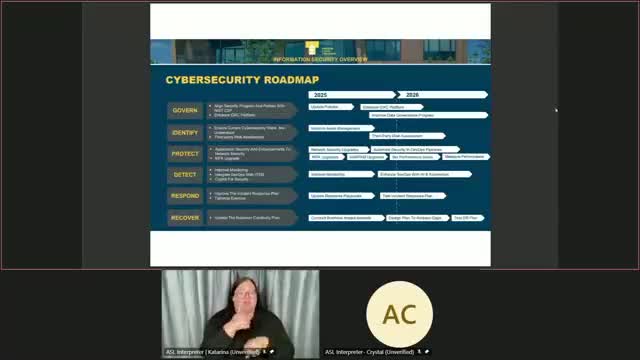Security Team reveals 2025 roadmap for enhanced cyber resilience and detection
May 23, 2025 | Information Management and Technology, Joint, Committees, Legislative, Oregon
This article was created by AI summarizing key points discussed. AI makes mistakes, so for full details and context, please refer to the video of the full meeting. Please report any errors so we can fix them. Report an error »

During a recent meeting of the Joint Committee on Information Management and Technology, Oregon legislators discussed significant advancements in the state's information security strategy. The meeting highlighted a comprehensive four-year roadmap aimed at enhancing the state's cyber resilience and response capabilities.
A key focus of the discussion was the implementation of a managed service provider that offers 24/7 detection services. This initiative has notably reduced the time required to acknowledge and respond to security incidents, a critical improvement in the face of increasing cyber threats. The integration of artificial intelligence and automation into security operations was also emphasized, allowing personnel to concentrate on more significant threats while streamlining routine processes.
The roadmap aligns with six strategic objectives, which include enhancing cloud security and transitioning from traditional Security Information and Event Management (SIEM) tools to more advanced extended detection and response capabilities. The committee underscored the importance of multi-factor authentication (MFA) enhancements as part of their ongoing efforts to bolster security measures.
Additionally, the meeting referenced industry trends identified by Gartner, which reflect a broader movement towards embedding resilience and managing third-party risks in information security practices. These trends indicate that Oregon is not only keeping pace with national standards but is also proactively addressing emerging challenges in the cybersecurity landscape.
In conclusion, the discussions at the meeting signal a robust commitment from Oregon's government to strengthen its information management and technology framework. As the state continues to implement these strategic initiatives, it aims to enhance its overall cybersecurity posture, ensuring better protection for its digital infrastructure and sensitive data. The next steps will likely involve ongoing assessments and adjustments to the roadmap as new threats and technologies emerge.
A key focus of the discussion was the implementation of a managed service provider that offers 24/7 detection services. This initiative has notably reduced the time required to acknowledge and respond to security incidents, a critical improvement in the face of increasing cyber threats. The integration of artificial intelligence and automation into security operations was also emphasized, allowing personnel to concentrate on more significant threats while streamlining routine processes.
The roadmap aligns with six strategic objectives, which include enhancing cloud security and transitioning from traditional Security Information and Event Management (SIEM) tools to more advanced extended detection and response capabilities. The committee underscored the importance of multi-factor authentication (MFA) enhancements as part of their ongoing efforts to bolster security measures.
Additionally, the meeting referenced industry trends identified by Gartner, which reflect a broader movement towards embedding resilience and managing third-party risks in information security practices. These trends indicate that Oregon is not only keeping pace with national standards but is also proactively addressing emerging challenges in the cybersecurity landscape.
In conclusion, the discussions at the meeting signal a robust commitment from Oregon's government to strengthen its information management and technology framework. As the state continues to implement these strategic initiatives, it aims to enhance its overall cybersecurity posture, ensuring better protection for its digital infrastructure and sensitive data. The next steps will likely involve ongoing assessments and adjustments to the roadmap as new threats and technologies emerge.
View full meeting
This article is based on a recent meeting—watch the full video and explore the complete transcript for deeper insights into the discussion.
View full meeting
